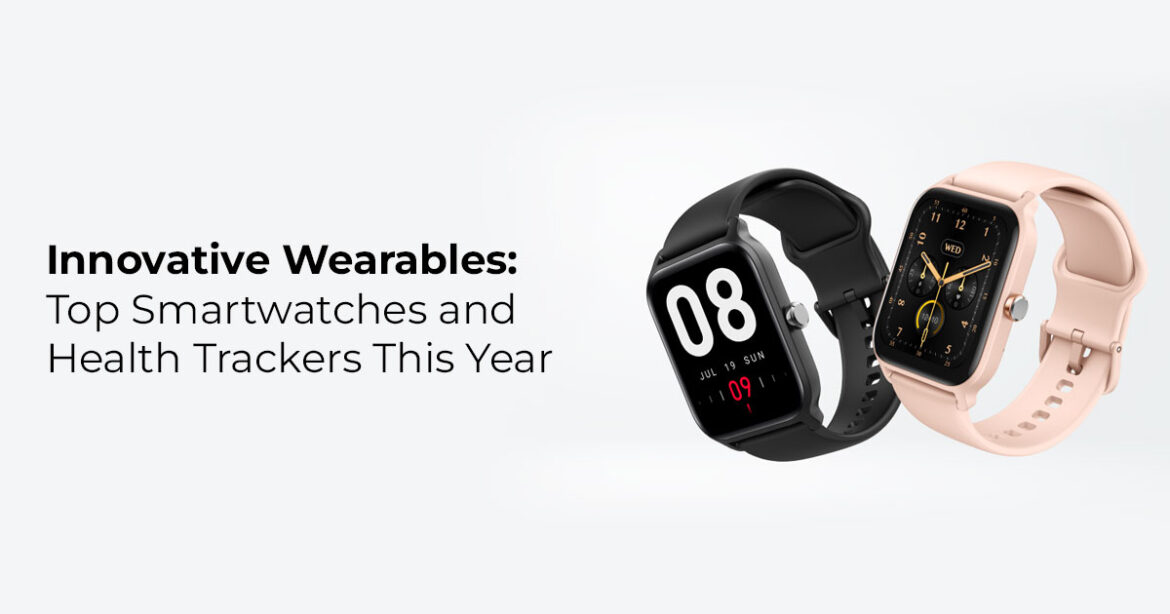Technology is no longer confined to our pockets or desks—it has moved onto our wrists. The rise of wearable technology has transformed the way we look at health, fitness, and personal well-being. This year, smartwatches and health trackers have evolved far beyond simply counting steps. They now deliver deep insights into our overall health, predict potential issues, and provide personalised recommendations.
As we step deeper into 2025, the market is overflowing with choices. From budget-friendly fitness trackers to high-end smartwatches, consumers now have access to devices that suit every lifestyle. But with so many options, which ones truly stand out? Let’s explore the top innovations in wearables this year and understand how they are reshaping the way we live.
The Evolution of Wearables
A decade ago, wearables were basic devices designed to count steps and measure heart rate. Today, they have become health companions capable of:
- Monitoring blood oxygen (SpO₂) and ECG
- Tracking stress levels and mental well-being
- Offering AI-powered health insights
- Detecting sleep disorders and circadian rhythm misalignments
- Delivering real-time coaching for workouts
- Providing predictive alerts for early signs of illness
The shift from fitness-only tools to comprehensive health trackers shows how much demand has grown for proactive health management. With lifestyle-related diseases on the rise, wearables are now an essential part of preventive healthcare.
Key Trends Defining Wearables in 2025
1. AI-Powered Health Insights
The biggest leap forward this year is the integration of artificial intelligence. Instead of merely showing raw numbers, devices now analyse trends and predict outcomes. For example, a smartwatch may alert you about potential sleep apnea, irregular heartbeat, or even stress triggers before you consciously notice them.
2. Advanced Sensors for Accuracy
Modern health trackers are packed with sensors—multi-channel heart rate sensors, ECG monitors, body temperature trackers, and advanced GPS systems. Dual-band GPS ensures accurate distance measurement, whether you’re cycling through mountains or running in a crowded city.
3. Extended Battery Life
Earlier, the biggest drawback of wearables was the need for frequent charging. In 2025, new smartwatches can last over 10 days, while some fitness trackers push beyond 30 days. This means uninterrupted sleep tracking and health monitoring without the hassle of daily charging.
4. Holistic Wellness Tracking
Beyond physical fitness, wearables now focus on mental health. Features like stress monitoring, guided breathing, recovery scores, and mindfulness reminders encourage users to take a more balanced approach to health.
5. Medical-Grade Features
Some premium smartwatches have received certifications for medical use, making them almost like mini diagnostic devices. With features such as ECG analysis, respiratory tracking, and vascular health monitoring, they bring professional-level insights to everyday users.
Top Smartwatches and Health Trackers in 2025
Here’s a roundup of the standout devices leading the market this year:
| Device | Key Features | Battery Life | Best For |
| Garmin Venu 4 | AMOLED display, advanced sleep tracking, accurate heart rate sensor, health alerts | Up to 12 days | Stylish professionals and active individuals |
| Samsung Galaxy Watch8 / Classic | Brighter screen, circadian rhythm guidance, stress monitoring, antioxidant index, dual-band GPS | 5–7 days | Android users wanting premium health tracking |
| CMF Watch 3 Pro | 131 sports modes, AI coaching, improved sleep tracking, accurate heart rate sensor | ~13 days | Fitness enthusiasts seeking value |
| Withings ScanWatch 2 | Monitors 35 health metrics, predictive alerts, and AI-powered health insights | Up to 35 days | Preventive healthcare users |
| Fitbit Sense 2 | ECG, stress monitoring, skin temperature tracking | ~6 days | Health-conscious users |
| Fitbit Versa 4 | Affordable, fitness-focused with GPS | ~6 days | Beginners wanting a reliable fitness tracker |
| WHOOP Strap 5.0 | Strain, recovery, blood pressure wellness, no display | 4–5 days | Athletes and professionals focused on recovery |
- Garmin Venu 4
The Garmin Venu 4 offers a perfect blend of fitness tracking and style. With its bright AMOLED display and premium build, it appeals to professionals who want elegance without compromising performance. New features include advanced sleep tracking, detailed health alerts, and improved heart rate sensor accuracy. Its battery life stretches to nearly two weeks, making it a strong competitor.
Best for: Active individuals who need durable yet stylish wearables.
2. Samsung Galaxy Watch8 & Watch8 Classic
Samsung continues to dominate the Android smartwatch market with the Galaxy Watch8 series. With a 50% brighter screen and lighter build, it feels more comfortable for all-day wear. New features like Bedtime Guidance for circadian rhythm alignment, vascular load monitoring, and an antioxidant index make it one of the most advanced smartwatches available.
Best for: Android users seeking premium health tracking and wellness features.
3. CMF Watch 3 Pro by Nothing
This device redefines mid-range wearables with 131 sports modes, AI-driven running guidance, and real-time coaching. The watch’s heart rate sensor is more accurate than before, and sleep tracking has improved significantly. With nearly two weeks of battery life, it’s one of the best value-for-money options.
Best for: Fitness enthusiasts who want professional-level guidance at an affordable price.
- Withings ScanWatch 2
Withings is known for focusing heavily on health, and the ScanWatch 2 proves it once again. It monitors 35 different metrics, including respiratory rhythm and menstrual cycle predictions. Its standout feature is its AI-powered predictive alerts, which can warn users about potential health issues before they escalate. Plus, the device offers up to 35 days of battery life.
Best for: Users who value preventive healthcare features and long battery performance.
5. Fitbit Sense 2 and Versa 4
Fitbit continues to serve the everyday health-conscious crowd. The Sense 2 brings advanced features like ECG, stress monitoring, and skin temperature measurement. Meanwhile, the Versa 4 is a lighter, more affordable version focusing primarily on fitness tracking. Both deliver strong ecosystem support via the Fitbit app.
Best for: People who want reliable fitness trackers with proven app support.
6. WHOOP Strap 5.0
The WHOOP Strap isn’t a traditional smartwatch; it’s a dedicated health tracker focusing on performance, strain, and recovery. The device doesn’t have a screen—it’s all about accurate data collection. Its new features include blood pressure wellness checks and advanced recovery insights, making it a favourite among professional athletes.
Best for: Athletes and fitness enthusiasts focused on optimising recovery.
Choosing the Right Wearable
With so many options, the decision can feel overwhelming. Here are some things to consider before buying your next smartwatch or health tracker:
- Purpose – Do you want a daily health companion, a workout coach, or a device for medical insights?
- Battery Life – If you dislike frequent charging, opt for devices like the Withings ScanWatch or the Garmin Venu 4.
- Accuracy – Always check the quality of sensors, especially for ECG, heart rate, and GPS.
- Design & Comfort – A device worn 24/7 should feel comfortable and look good.
- Budget – While high-end models offer advanced features, mid-range wearables now deliver excellent value for money.
- Ecosystem – Consider app support and whether it integrates with other apps like Google Fit, Apple Health, or Strava.
Common Challenges with Wearables
While technology has advanced, there are still some hurdles:
- Battery Life Trade-Offs: More features often mean shorter battery life. Always-on displays and continuous monitoring can drain power quickly.
- Medical Accuracy: Not all devices with ECG or SpO₂ claims are approved for clinical use.
- Data Privacy: With so much health data being collected, privacy policies should be reviewed carefully.
- Glucose Monitoring: Although hyped, reliable non-invasive blood glucose measurement is still in development.
The Future of Wearables
Looking ahead, we can expect wearables to integrate even more deeply with healthcare systems. Doctors may soon prescribe smartwatches as part of treatment plans, with data directly shared for analysis. AI will also continue to refine predictive insights, making it possible to prevent health crises before they occur.
Augmented reality features, advanced body sensors, and even integration with smart clothing could be the next wave of innovation. The line between a fitness device and a medical-grade health monitor is blurring rapidly.
Final Thoughts
2025 marks a new era for smartwatches and health trackers. They are no longer luxury accessories but essential tools for monitoring both fitness and overall well-being. From Garmin’s durability to Samsung’s AI-driven wellness, and from Fitbit’s simplicity to WHOOP’s athlete focus, there’s a device for everyone.
For most users, the Samsung Galaxy Watch8 offers the best mix of smart features and health tools. For those who want a balance of style and durability, the Garmin Venu 4 shines. Meanwhile, the Withings ScanWatch 2 and WHOOP Strap 5.0 lead in preventive and recovery-focused insights.
No matter which device you choose, one thing is clear: wearable technology is no longer about gadgets—it’s about empowerment, wellness, and taking charge of your health.

